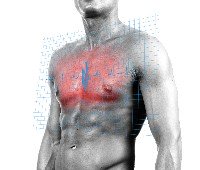|
Do you Know How to Recognize Heart Attack symptoms?Could you recognize common Heart Attack Symptoms in yourself Statistics from most other countries around the world are no less disturbing. While there is much that you can do to avoid becoming a statistic in the first place, knowing what to do if you are confronted with this situation individually or with your friends and family could save a life! 
In the movies or on TV, Heart Attacks - referred to as Myocardial Infarction (MI) by medical professionals are always portrayed as sudden, completely unexpected and very intense. You've got to keep your audience entertained somehow right? The truth is that most Heart Attacks start slowly with mild pain and discomfort, in fact some can even be "silent". OK...so what heart attack symptoms are common? An individual may experience one or a combination of several factors. These include.... Chest Pain or Angina.
Remember. Chest pain, Central, Heavy Weight, Squeezing, Fullness. The presence of any of these symptoms doesn't always mean that an individual is having a Heart Attack but this should always be assumed to be the case until proper diagnostic tests have completely ruled it out. 
Radiating or Spreading pain. Pain can be experienced in several areas other than the chest. The pain can occur in isolation or in combination. Common radiating pain can be present in.... The pain can be mild or intense and include sensations like..... As previously mentioned, that heavy weight sensation may also be present in the chest or stomach area. General Symptoms. General symptoms are symptoms that you might recognize as being common to all kinds of different conditions or illnesses for example the Flu! An individual may also feel some anxiety or nervousness. Individually, general symptoms - on their own shouldn't be classed as heart attack symptoms and don't necessarily indicate the onset of a heart attack. However, in combination with one or more of the pain and chest symptoms outlined above, you should be immediately suspicious.
Seek the immediate advice of a trained health care professional or emergency care provider. Heart Attack symptoms in men versus heart attack symptoms in In both men and women, the most common symptoms of heart attack are chest pain or chest discomfort. women are to some degree more likely than men to experience some of the other symptoms, especially.... Every type of pump, whether it be the human heart or a mechanical device used in industry requires its own unhindered supply of fuel to maintain its proper function. A pump's function is to maintain adequate pressure within the system that it is connected into so that it can push and pull a substance like blood, water, hydraulic fluid...whatever from point A to point B and back again, continuously, flawlessly, indefinitely. Heart Attack Symptoms are your body's way of alerting you to a potential failure of this vital pump due to a partial or complete blockage in one of the "fuel lines" - your Coronary Arteries. The heart of an individual experiencing these symptoms is struggling to maintain its correct function. The heart muscle is being starved of oxygenated blood and vital nutrients. This situation makes it extremely difficult for the heart to maintain an adequate blood supply and blood pressure to the rest of the body. If left unchecked, this can very quickly lead to a Heart Attack or Cardiac Arrest situation resulting in serious damage to the heart muscle or death of the individual. Now that you can confidently recognize important Heart Attack symptoms, Always seek immediate emergency medical intervention when confronted with this situation.
Portable Automated External Defibrillators or AED's can save lives and they're becoming more and more common. learn more here >>
Return from Heart Attack Symptoms to Coronary Heart Health Home page
|



